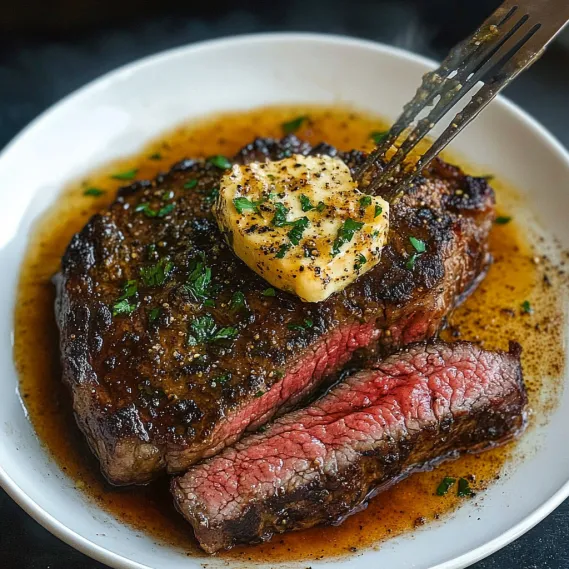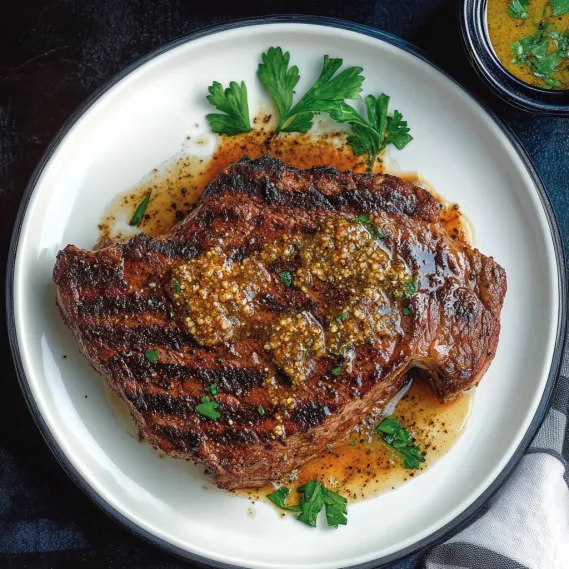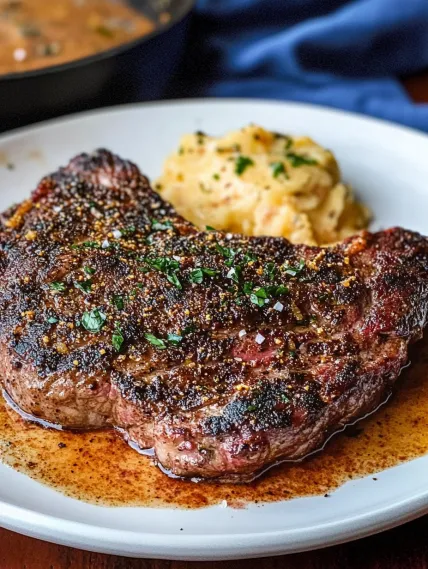 Pin it
Pin it
This intensely flavorful blackened steak has transformed my weeknight dinners into restaurant-quality experiences without the hefty price tag. The combination of bold Cajun spices and the decadent cowboy butter creates a perfect harmony that elevates a simple steak to something truly special.
I discovered this recipe after a memorable trip to New Orleans where I fell in love with Cajun cuisine. After several attempts to recreate those bold flavors at home, this blackened steak became my signature dish that friends now request whenever they visit.
Ingredients
- 1 ribeye steak: about 1 pound and 1½ inches thick, perfect for its marbling that creates unmatched flavor and juiciness
- 1 tablespoon Cajun seasoning: providing the signature blackened flavor profile with its blend of peppers, herbs, and spices
- 1 teaspoon paprika: adds beautiful color and mild smoky sweetness
- ¼ teaspoon kosher salt: enhances all the flavors without making the dish too salty
- ¼ teaspoon black pepper: freshly ground, offers the best aromatic quality
- 2 tablespoons extra virgin olive oil: helps create the perfect sear and prevents sticking
- 3 tablespoons Cajun Cowboy Butter: divided between cooking and finishing for maximum flavor impact
How To Make Blackened Steak With Cajun Cowboy Butter
- Temperature Equilibrium:
- Remove steak from refrigerator 30 to 45 minutes before cooking, allowing it to reach room temperature, which ensures even cooking throughout. This step is absolutely critical for the perfect doneness especially with thicker cuts like ribeye or strip steak.
- Surface Preparation:
- Pat the steak completely dry using paper towels, pressing firmly to remove all surface moisture. This might seem minor but is actually crucial since any excess moisture will steam the meat instead of searing it properly, creating that beautiful crust we want.
- Seasoning Application:
- Combine all the dry spices in a small bowl, mixing thoroughly to distribute the flavors evenly. Apply the seasoning blend generously to both sides of the steak, pressing gently with your fingers to help it adhere to the meat surface. The seasoning should form a visible crust that will blacken beautifully during cooking.
- Skillet Preparation:
- Heat a cast iron skillet over medium high heat until it reaches the smoking point, which typically takes 3 to 4 minutes. A properly preheated skillet is non-negotiable for developing that characteristic blackened exterior. Add olive oil and swirl to create an even coating across the entire cooking surface.
- Searing Technique:
- Using tongs, carefully place the seasoned steak into the hot skillet, allowing it to cook undisturbed for a full 3 minutes. Resisting the urge to move the steak during this time ensures proper crust formation. Flip once and cook the second side for 2 to 3 minutes depending on thickness.
- Butter Basting:
- After flipping, introduce 2 tablespoons of the Cajun Cowboy Butter to the pan where it will immediately begin to foam and sizzle. Using a large spoon, continuously collect the melting butter and pour it over the top of the steak during the final cooking minute, creating flavor depth and moisture.
- Resting Period:
- Transfer the cooked steak to a cutting board and let it rest, untouched, for 5 minutes. During this time, top with the remaining tablespoon of Cajun Cowboy Butter allowing it to melt and infuse additional flavor as the steak fibers relax and reabsorb juices.
 Pin it
Pin it
The Cajun Cowboy Butter is truly the secret weapon in this recipe. I discovered its transformative powers when experimenting with compound butters and have never looked back. My family particularly loves when the butter melts into the hot steak, creating pockets of intense flavor in every bite. Even my father-in-law, who claims to be a steak purist, requested the recipe after his first taste.
Temperature Guide
The difference between a good steak and an exceptional one often comes down to proper temperature control. For medium-rare, aim for an internal temperature of 130 to 135°F before resting or 125°F if you prefer rare. Medium doneness requires 140°F, and well-done would be 150°F and above. Remember that carryover cooking will increase the temperature by about 5 degrees during the resting period, so always remove the steak from heat slightly before reaching your target temperature.
Perfecting The Blackened Crust
The signature element of this dish is the darkened spice crust that forms during cooking. This isn't burning; it is the controlled caramelization of spices that creates complex flavor. The key is maintaining the right heat level throughout cooking. If your stove runs hot, reduce to medium heat to prevent actual burning while still achieving the blackened effect. The spice crust should be dark and aromatic with a slight crispness that gives way to tender, juicy meat inside.
 Pin it
Pin it
Serving Suggestions
This blackened steak pairs beautifully with classic Southern sides like creamy mashed potatoes, buttermilk biscuits, or dirty rice. For a lighter option, try serving alongside a fresh arugula salad with lemon vinaigrette; the peppery greens and bright acidity balance the richness of the steak perfectly. If you want to embrace the New Orleans inspiration, consider adding grilled corn on the cob with more of the Cajun butter or a side of creole green beans. For a complete restaurant experience at home, slice the steak against the grain and fan it out on a warmed plate with butter sauce drizzled over the top.
Storage And Reheating
While steak is best enjoyed fresh, leftover blackened steak can be stored in an airtight container in the refrigerator for up to 3 days. To reheat without overcooking, place the steak in a 275°F oven until it reaches an internal temperature of 110°F, about 15 to 20 minutes. Then quickly sear in a hot skillet for 30 seconds per side to restore some of the exterior texture. Alternatively, cold leftover blackened steak makes an extraordinary addition to salads, sandwiches, or breakfast hash, offering bold flavor without requiring reheating at all.
Frequently Asked Questions
- → What cut of steak works best for this dish?
A ribeye or New York strip steak about 1 ½ inches thick works best for this dish, as they have a great balance of tenderness and flavor.
- → How long should I let the steak rest before cooking?
Allow the steak to rest at room temperature for 30 to 45 minutes before cooking. This helps it cook more evenly.
- → What’s the key to achieving a good crust?
Ensure the steak is patted dry and the skillet is extremely hot before searing. Pressing the seasoning evenly into the steak also helps.
- → How do I know when the steak is cooked to my liking?
Use an instant-read thermometer. For medium doneness, remove the steak at 140°F as it will continue cooking slightly while resting.
- → Can I substitute Cajun Cowboy Butter?
If you don’t have Cajun Cowboy Butter, you can mix melted butter with garlic, paprika, and a touch of Cajun seasoning as a substitute.
